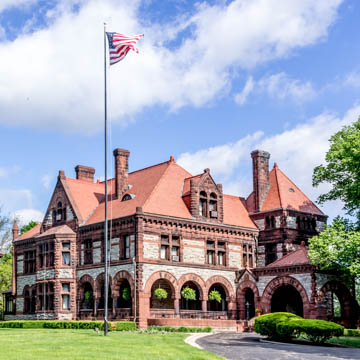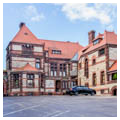The Asa S. Bushnell House is a testament to Springfield’s heyday as an industrial center at a time when the state of Ohio played an important role in the country’s industrial growth after the Civil War. If the scale of the house, built by an important industrialist who was later governor of Ohio, demonstrates accumulated wealth, its unified design, rich textures, and contrasting materials illustrates the architectural influence and legacy of Henry Hobson Richardson.
Asa S. Bushnell was a partner in Warder, Bushnell and Glessner, one of the nation’s most successful manufacturers of farm machinery. The company was headquartered in Springfield, which called itself “Champion City” in honor of the company’s famed Champion Reaper. In 1886, Bushnell became the company’s president when founder Benjamin H. Warder retired from day-to-day operations. Company vice president John J. Glessner was already established in Chicago, where he oversaw the firm’s main sales office. Glessner and his wife, Frances, had hired Boston architect Henry Hobson Richardson to design their Prairie Avenue house, and Warder and his wife Ellen were doing the same, having secured Richardson to design what would become their primary residence on K Street in Washington, D.C. Asa and Ellen Bushnell hoped to follow the partners’ lead for their own new house in Springfield. In July 1886, the Bushnells secured what they considered an ideal three-acre lot on a natural ridge on East High Street, then Springfield’s most fashionable address. They were familiar with the land, as it sat directly across the street from where they were currently living, and though they had no design in hand, they nonetheless filed a $100,000 residential building permit that summer.
Unfortunately for the Bushnells, Richardson had died in April of that year and his successor office, Shepley, Rutan and Coolidge, had so many unfinished projects that the firm would accept no new clients until January 1887. Thus the Bushnells turned to Robert H. Robertson, a New York–based architect whom the Glessners had considered for their house in Chicago. Robertson’s earlier commissions for Knox Presbyterian Church and St. James Episcopal Church, both in Manhattan, showed that he was a capable interpreter of Richardson’s signature style. The Bushnells traveled to New York over Thanksgiving 1886 and stayed near Robertson’s East 23rd Street office. In January, they visited the Glessners in Chicago to talk over their plans and to visit several construction sites, including the MacVeagh House and the Glessners’ own home, both by Richardson. Robertson came to Springfield later in the month to survey the Bushnell’s selected site. Although plans were still being developed, the Springfield Republic was confident in reporting that the new house, “will be a stone structure and totally unlike anything else in Springfield.”
By the early spring of 1887, demolition of the previous house on the site was complete and excavation for the new foundations was underway. Joachim Matheson, a young Norwegian architect in Robertson’s office, had moved to Springfield to supervise the construction, which was being carried out by Richardson’s go-to contractors, the Norcross Brothers of Wooster, Massachusetts, who had also completed the Warder and Glessner houses. By the fall, the Springfield Republic noted that the house was “nearly up to the third story.” The house was completed and occupied by autumn of 1888.
As the first example of the Richardsonian Romanesque style in Springfield, the Bushnell House drew considerable attention. During the construction, the Champion City Times commented on what it regarded as an unusual design: “Numerous double windows ornamented above with oddly dressed stone, eye brow windows or better known as roof peeps, red turrets surmounting the outer angles, tall chimneys towering over the roof, quaint piazzas, the porte cochere and the drives around give the new residence a medieval appearance and lend to it a beauty and a grandeur seldom surpassed in modern architecture.” In its overall effect, the house is reminiscent of Richardson’s early attempts to push Romanesque revival forms in a new direction, using stone to create complex exteriors rich in color and texture. For the Bushnell House, Robertson employed two types of stone on the main elevations. The body of the superstructure is composed of a rock-faced blue Ohio River limestone. For the cornice, window surrounds, detailing, and decorative elements, Robertson selected red sandstone from the Norcross quarries in East Longmeadow, Massachusetts. Alternating shades of light and dark sandstone on the many arches recall such Richardson projects as Winn Memorial Public Library (1876–1879) in Woburn, Massachusetts and some of Robertson’s own previous buildings, including St. James Episcopal Church (1884–1885).
Robertson designed the house in an L-shaped plan. The larger section fronting on East High Street housed the family’s quarters. A large servant wing, designed in a similar style, extends to the rear. Robertson placed the entrance on the east side of the house, accessible through an arched entry or by the attached porte-cochere. A massive oak door in the Richardsonian Romanesque style leads into the foyer. Asa’s private study opens off this foyer, as does the massive central hall, which serves as the house’s organization spine. First-floor family spaces, including the sitting room, parlor, and dining room, are all accessible from the hall. Glass doors open onto a loggia cut into the house’s southwest corner. In the classic Richardsonian fashion, a grand staircase cascades into the main hall, inviting visitors to the second floor. The upper hall provided access to three family bedrooms and two private chambers; it also served as the family’s picture gallery, containing their fine collection of American and European paintings. The servant’s quarters connect to the main house through a door on each floor. On the first floor, this leads to a servant hall that runs the length of the house; Richardson’s Glessner House has a similar arrangement.
Although the site is only three acres, the grounds provide a dramatic setting for the house, which, as the Champion City Times noted, is “advantageously situated on the crest of the ridge running north of High Street.” The property slopes away from the house on three sides into broad lawns with minimal adornment. A limestone wall capped with red sandstone runs the length of East High and Walnut streets, excepting small entrances cut into each, and turns into a retaining wall at the rear. A stone driveway originally snaked through the grounds, entering on High Street and exiting on the side.
Robertson designed two other structures for the property: the carriage house and caretaker’s house complement the design of the main residence, combining elements of the Romanesque Revival and the Shingle Style. Robertson used stone for the first-floor elevations and clad the upper facades in diverse materials. The carriage house is more Shawvian in its exterior treatment, with decorative red tile employed on vertical surfaces and on the complex multi-tier roof. For the gables, Robertson used a combination of red tile, half timbering, and decorative scrollwork, along with strips of multi-paned windows. In the caretaker’s house, Robertson clad the vertical surfaces with three types of wood shingles that are more Richardsonian in their appearance. Although considerably smaller than both the main residence and carriage house, the caretaker’s house combines elements of both for a harmonious effect. It is also more playful, with a circular window, rounded corner, and a large incised carving of the year of construction on the principal elevation.
After Asa Bushnell’s death in 1904 the family sold the property and it remained a private house until the 1930s when Austin Richards purchased it for use as a funeral home. Now known as the Richards, Raff and Dunbar Memorial Home, it is still in operation for funeral services. Architectural tours of the house are available by appointment.
References
Berkhofer, George A., “East High Street Historic District,” Clark County, Ohio. National Register of Historic Places Inventory–Nomination Form, 1974. National Park Service, U.S. Department of the Interior, Washington, D.C.
Berkhofer, George A. No Place Like Home: A History of Domestic Architecture in Springfield and Clark County, Ohio. Wilmington, OH: Orange Frazer Press, 2007.
Ochsner, Jeffrey Karl. H.H. Richardson: Complete Architectural Works.Cambridge: MIT Press, 1982.






